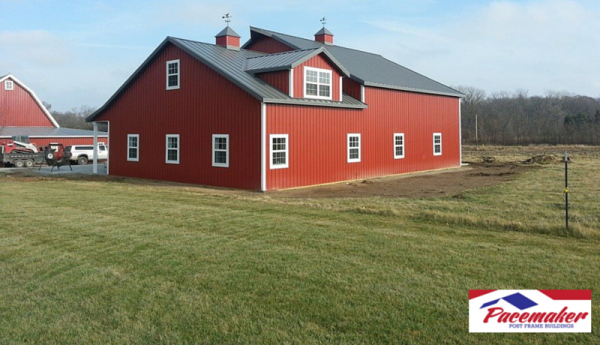Post frame buildings are engineered wood-frame systems featuring large, widely spaced supporting columns. Post frame buildings have many benefits that make them an ideal choice for commercial construction, barns, and storage facilities. Advantages of a post frame building include, but aren’t limited to, cost effectiveness, energy efficiency, sustainability, durability, and design flexibility. Here are the reasons you’ll want to consider a post frame building for your next construction project.
Fast Assembly
Pole barns are often constructed quickly. You can get a building up in much less time than alternative construction techniques. The framing members in a post frame building span further apart and generally larger, so fewer are required to complete the construction. A building can be built at any time of the year, as it’s possible to add concrete flooring after the completion of the buildings main structure.
Affordability
It’s quick and efficient to construct a pole barn quickly so you’ll incur fewer expenses in the form of labor costs, especially if you don’t need a poured concrete foundation. Wood is usually cheaper than steel, concrete blocks or brick. In the event that you opt to use steel for your siding and roofing, you’ll spend less on a pole barn project. The installation of steel is quick and efficient saving you money on overall labor costs.
Flexibility
Post frame buildings allow for efficient and cost effective additions such as overhangs, porches and roof extensions. This is not necessarily the case with other types of building construction. Post frame buildings do not require interior walls for support, which allows for an open floor plan layout and design. Post frame buildings will allow you to place the supporting columns six to eight feet apart, so you can add extra doors and windows later on, unlike stud walls that pose challenges and expense when adding new openings. Pole barns will also give you a wide range of exterior options besides steel, including block, wood, brick, and vinyl.
Enhanced Strength
Post frame buildings are significantly stronger than those produced with alternative forms of construction. This is attributable to the following factors:
- The columns go all the way into the ground, making the building extremely stable and reducing any shear point above grade.
- The horizontal girts that connect the post columns create a strong diaphragm system that works together to provide an engineered system to exceed both snow and wind load requirements.
- Post frame construction involves the direct attachment of trusses to the post column frame making it an exceptionally strong overall system.
Improved Energy Efficiency
Post frame buildings have larger wall cavities that allow greater insulation installation. The wood post columns conduct minimal heat transfer. In contrast, steel frame buildings conduct heat at a significantly faster rate, making them more difficult to heat and cool. Concrete buildings are even more challenging and expensive to insulate due to additional furring requirements.
Post frame buildings are often preferred due to their ease of maintenance and being environmental friendly. They use wood framing, a renewable resource that—with responsible usage—will not contribute to deforestation. Other building materials like vinyl release noxious gas; a wood frame is natural and doesn’t release any toxic fumes. This makes post frame structures a popular choice among builders and consumers.
If you are considering a post-frame building, download our free planning guide which includes a checklist of items you’ll want to prepare for and think through for any building project.
DOWNLOAD NOW >>

